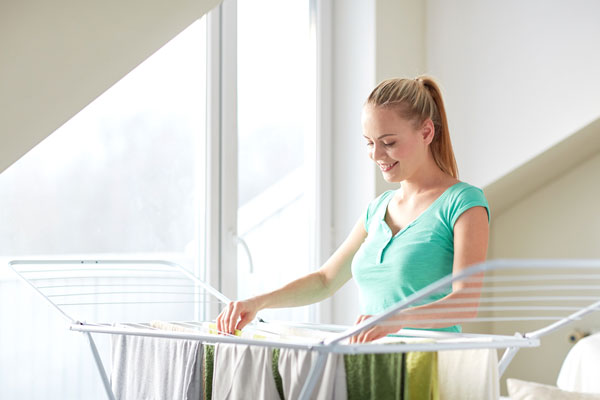Appliance options are more varied now than ever before. There was a time when a tumble dryer was the only option apart from hanging clothes out to dry, but not anymore. Today, we have options for both a heated airer and a tumble dryer, but how do you make the choice? Enthusiasm can be seen for both products, so if you are in the market for a new tumble dryer or airer, here is what you need to know.
Plenty of Options for Both
Tumble dryers come in a variety of types to choose from and not surprising, heated airers do to. Everyone has their favourite brand, but when your tumble dryer has dried its very last set of clothes and you are seeking something different, the temptation to purchase a new heated airer is significant. We will help you work through the hype and discover the best option for your individual needs.
| Tumble Dryer | Heated Airer | |
| Initial cost | £220 – £800 | £80 – £160 |
| Fast drying | ✅ | ❌ |
| Better costs to run in longer period | ✅ | ❌ |
| More options & features | ✅ | ❌ |
| Compact & lightweight | ❌ | ✅ |
| Safer for clothing | ❌ | ✅ |
| Better for big families | ✅ | ❌ |
| Better for smaller flats / houses | ❌ | ✅ |
| Can be stored when not in use | ❌ | ✅ |
| Easy to setup / install | ❌ | ✅ |
Dries More Clothes
On first inspection, one might think that a heated airer dries more clothes. These systems can hold up to 15kg of wet clothing which is a significantly large load. A tumble dryer comes in a range of sizes where drum sizes can range between 6kg and 11kg of wet clothing. Naturally, the more clothes you intend on drying throughout the day, the larger drum capacity will be required. However, drum capacity is not the only variable at play in this instance. Time is a factor as well.
For the average family using a tumble dryer, multiple loads of laundry can be dried remarkably quickly. Generally, within an hour, possibly 2 depending on the settings, a load will be fully dried. As for a heated airer, it takes a little longer to dry clothing completely. Although it is larger, more time will be spend drying a full load, so this certainly needs to be factored into your decision. In most instances, it can take all day to dry a load in a heated airer.
Small or single families can often justify the increased time used to dry laundry. Drying clothes throughout the day or night is not a problem as the drying will take place while you are at work or sleeping. However, for a busy family, with multiple people in the home, a tumble dryer simply makes more sense.
Costs to Run
Appliances, even energy efficient varieties, cost money to run each month. A savvy homeowner understands the value of calculating each appliance and their possible drain on energy costs. Where your heating and cooling tend to be the largest expenses, taking up to half of your home’s energy cost, other appliances matter as well. Refrigerators, stoves, dishwashers, and yes, even the dryer require a set monthly cost.
Running costs for heated airers and tumble dryers vary by make and model. Some run more efficiently than others and certain models can put a large drain on energy expenses. Each model is given an energy rating, but the true calculation comes in how much the appliance will be used.
For large families, that do a lot of laundry, naturally the appliance will be used more frequently. However, if you are a single person or a couple sharing a home, the amount of laundry will be drastically lower. Consideration for the amount you pay before purchasing a tumble dryer or heated airer can make your choice a little easier.
Instead of calculating monthly energy expenses, break it down into weeks. Calculate how much laundry you do on an average week. A heated air dryer utilizes an average of .3kWh each hour. In this instance we will assume your heated air dryer will dry clothes for 8 hours at a time. The total usage for that amount of time is 2.4 kWh per load.
Although energy prices vary throughout the year, let’s account for current energy costs of .34/kWh (2022). Each heated airer load of laundry would cost .82 per load on an 8 hour cycle.
Conversely, a tumble dryer will cost about 4.5 kWh of electricity for every cycle, so calculations with the same energy costs would be 1.53 for every load of laundry.
Due to the nature of heated air dryers, they are cheaper to run per cycle, but will cost more in time. Tumble dryers take less time to dry, but cost more per load. However, take comfort in knowing that more energy efficient tumble dryer models are being introduced. Shop around for the right model for your needs and calculate energy usage based on your home’s laundry necessities.

Example of good tumble dryer: Hoover H-Dry 300
- Max load: 9kg
- Digital Display
- Anti Crease
- In door water collection

Example of good heated airer: Concise
- Max load: 15kg
- 1000W power
- Foldable
Initial Costs
Running costs are not the only thing you will have to contend with when choosing which type of laundry dryer to invest in. A general tumble dryer can cost £150 for the most basic model, but for increased energy efficiency and features, some dryers cost upwards £1000. The more you pay, the better efficiency you will receive, but it really depends on your initial cost budget and needs of the family.
An inexpensive tumble dryer may also have more drawbacks. Some models may work on a lower wattage, but leave clothes slightly damp. When it comes to tumble dryers, it is almost always more beneficial to pay a slightly higher price for a more efficient model. You want to ensure your appliance actually dries clothes fully.
As for a heated airer, initial costs are far less.
A unit will cost between £40 and £200. The primary drawback to a heated airer is lack of extra features. If you desire more customizable laundry options, you will be disappointed with a heated airer. However, for those seeking just basic drying, they are excellent options.
With both, the more features you have and the larger the appliance, the more its initial cost will be. Take consideration on how much laundry you need and what you need from the appliance when choosing whether to purchase a tumble dryer or heated air dryer.
Finding the Practical Choice
We all have to do laundry at some point and everyone has their own method to madness, if you will. Practical means of doing laundry will be different for every household. Large and even average sized families tend to do more laundry.
Families with babies certainly do a lot of laundry, and those with busy social lives need to have appliances that fit around their schedules.
A tumble dry requires specific exhaust and electrical requirements for most models. There are some models that no longer require an outside exhaust for the unit, but older models will. This may require alterations to your existing electrical outlets and access to vent the unit outside. Making those alterations can add to the cost of owning a tumble dryer.
However, owning your own tumble dryer means you do not have to seek alternatives for drying your clothes. You can set the system and forget it while at work, out with friends, or while running errands. These units do cost more to run per load, but often, the additional cost is more practical to ensure laundry is completed on a strict schedule.
A heated airer can be cheaper to purchase and costs less per load to operate. They are also easy to install and require virtually no alteration to the space. Heated airers can also be set up in any room and take up very little space, so they are ideal for smaller spaces. Another key component to heated airers are how gently they dry clothes. Tumble dryers can sometimes damage delicate fabrics, but a heated airer will not.
Drawbacks to heated airers are the time it takes to dry clothes. A cycle can take up to 8 hours making it impractical for those who require more laundry cycles each day. These units are also lighter which may be great, but with rambunctious children running about, the potential for knocking the unit over can be significantly high.
Which to Choose
A heated airer has its place. As does a tumble dryer. Both do the job of drying clothes effectively and both have their advantages and disadvantages. When making the choice for your home, carefully consider each option and what they will bring to your laundry routine.
In many instances, homeowners and renters will choose one or the other based on their individual needs. However, if space allows and you have the ability, using both options can be remarkably beneficial.
A tumble dryer can be available for when you need to dry clothes quickly or have a lot of laundry to dry and a heated airer will be there for you on those days where laundry is not at the top of the list. Additionally, it is nice to have an extra way to dry clothes if one or the other fails. A heated airer is a great alternative if you need a safer way to dry clothes making it a great alternative to laundering delicate items professionally.
There is no right or wrong answer here. Some people will prefer the quiet nature of a heated airer while others want the fast drying ability of a tumble dryer. Take the time to examine your needs and your preferred laundry routine. Each of these options are excellent and have substantial benefits. Whether you choose a heated airer or a tumble dryer, the end result of clean, dry laundry is the only thing that truly matters.
Are there any other options?
Of course! We wrote about great benefits of using dehumidifier to dry clothes before. Check it out here.
Last update on 2025-02-28 / Affiliate links / Images from Amazon Product Advertising API






